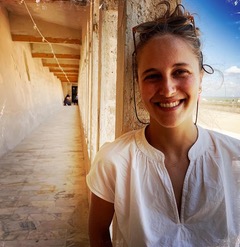PIETRO art gallery in Bologna continues its exhibition program by confirming the will of presenting irregular artists who investigate above all the field of architecture. The curator of the exhibition “Vola”, Marcello Tedesco, recently presented the two large canvases by the Bolognese painter Roberto Rizzoli, in the wake of a years-long curatorial and educational journey, which took place along the guiding path of other radical and humble artists like Cesare Zavattini (Aspettando Za, una non mostra dalla collezione Massimo Soprani, 2021) or Carlo Levi (Paura della libertà, un omaggio a Carlo Levi, 2022). It is no coincidence that it is Tedesco’s brotherly love that curates the exhibition of another of his life masters, and that Roberto Rizzoli let himself to be led by the hand onto the exhibition scene after long and voluntary years of absence.

Roberto Rizzoli, Vola, 1996. Plaster and acrylic on canvas. Ph. Chiara Vitofrancesco, courtesy PIETRO, Bologna
The two large canvases on view – created in 1996 – appear to our eyes as perspective compositions. At first glance, it is their glimmer of granular essence that makes them appear like silk-screen prints, although behind these two architectures lies a process of artisanal gestation that took place in the wake of an intimate relationship with the pictorial materials. The two initial matt black walls act as an antechamber to a pictorial material that has pushed into the depths of the canvas. The “intermediate corridor” and the “studio” – respectively a sort of grid made of intermittent dots and an architecture of alternately thick and thin brushstrokes – constitute the vanishing point of this painting: the silk-screen appearance betrays the long application work of the acrylic on the canvas paste and its subsequent scraping. A fight for survival won by the layers of color penetrated into the most hidden depths of the support: the visible black parts “in relief”. The earth that emerges from Rizzoli’s work is subsequently leveled, so that it appears molded and cooled.

Roberto Rizzoli, Vola, 1996. Plaster and acrylic on canvas. Ph. Chiara Vitofrancesco, courtesy PIETRO, Bologna
Whoever finds themselves looking at these canvases will try to walk through them as they would in the presence of a real space, and perhaps they will clash with the parietal concreteness of the represented image: of its double, made of impassable matter. they will be forced to go back and recognize that yes – eventually – their own subjective value has been annihilated by the organic power of the object. Immediately afterwards they will turn around again because the cold initial impact was not without energy, and because the vibrations of this spatial corridor continue to tremble in their mineral and tragic pictorial essence. They will turn around once again and look – because, ultimately, painting is what you see – and maybe they will encounter what they have never been able to see, with what survives at the end of things, at the apparently unattainable horizon, what else is it just a new beginning. They will find themselves in the presence of the name of painting – to paraphrase Umberto Eco.

Roberto Rizzoli, Vola, 1996 (detail). Plaster and acrylic on canvas. Ph. Chiara Vitofrancesco, courtesy PIETRO, Bologna
In short, we can assert that there were two entities at play on these canvases: painting as image and painting as architecture. Painting itself and the space of painting. In a nutshell, a representation of painting itself. It is finally it, painting, that presents itself as independent and free from anecdote. It is therefore composition. The absurdity of this reality is also given by the ambiguity with which we are attracted to enter something that is fundamentally flat. The paradox continues if we consider that it is precisely the composition, which is invisible to our eyes, that keeps painting standing. Rizzoli builds by showing us something that normally cannot be seen. And this is also because his art has to do with the invisible structure of architecture, where this itself is compositional. The two canvases vibrate with the secret they are showing us – precious, humble, unruly, tragic. Thus, let’s turn our eyes again and perhaps those two spirits – respectively circular and rhomboidal in shape – will invite us, which with their geometric weight seem rather to levitate at the entrance of the painting. These inorganic ferrymen are so pulsating that they contribute to investing the two canvases that Roberto Rizzoli has chosen to donate to today with spirituality.

Roberto Rizzoli, Vola, 1996. Plaster and acrylic on canvas. Ph. Chiara Vitofrancesco, courtesy PIETRO, Bologna
Faced with the radical nature of the life of an artist like Rizzoli, his poetics and the sacredness of his gift, the question we can finally ask ourselves does not only have to do with reflection on the current state of painting. It also concerns the final choice made by the artist and curator together, who assume the risk of a contextual shift: the transfer of a marginal experience from a peripheral place to a center – the one used for the artistic fruition – naturally characterized by a certain type of environment. The task is also to ask ourselves – leaving a wide margin of doubt – whether this type of experiences can transition to a place to which they feel they least belong, and with what type of outcome.
Daria Ortolani
Info:
Roberto Rizzoli, Vola
curated by Marcello Tedesco
setting by Simone Gheduzzi
27/10/2023 – 8/12/2023
PIETRO
via Galliera 20, Bologna

Graduated in medieval art history at the Bologna Alma Mater Studiorum, she collaborates with the magazine by writing about contemporary art, with a careful eye on sculpture and photography.






NO COMMENT